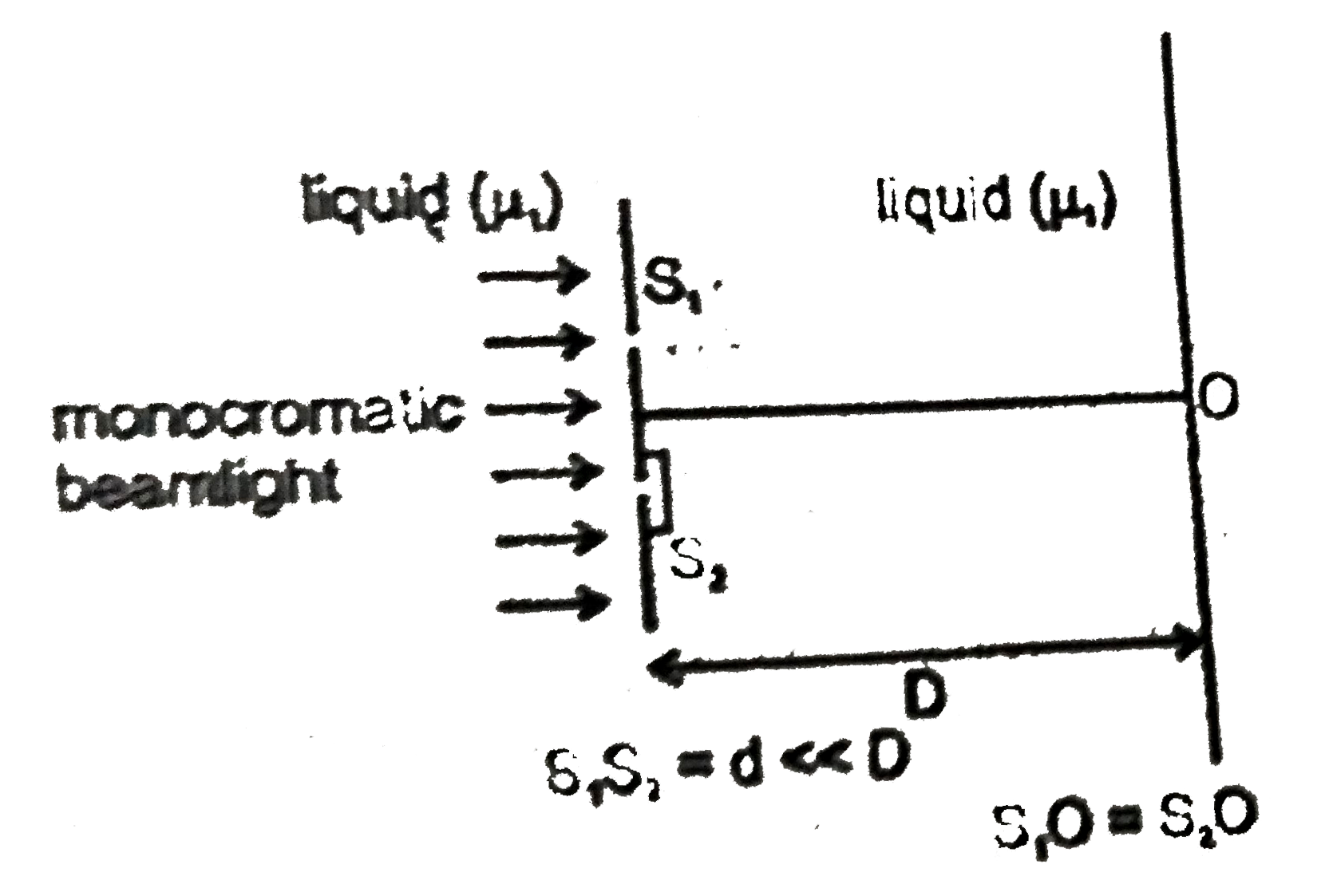Two transparent slabs having equal thickness but different refractive indices μ1andμ2, are pasted side by side to form a composite slab. This slab is placed just after the double slit in a Young's experiment so that the light from one slit goes through one material and the light from the other slit goes through the other material. What should be the minimum thickness of the slab so that there is a minimum at the point P0 which is equidistant from the slits ? Solution in Gujrati
The correct Answer is:A, B, D
The change in path difference due to the two slabs is (μ1−μ2)t (as in problem No. 16) For having a minimum at P, the path difference should change by 12
So, λ2=(μ1−μ2)t
→t=λ2[μ1−μ2]
Topper's Solved these Questions
Similar Questions
A light wave can travel
03:42View SolutionA concave mirror having a radius of curvature 40 cm is placed in front of an illuminated point source at a distance of 30 cm from it. Find the location of the image.
05:31View SolutionAn alpha particle is projected vertically upward a speed of 3.0X104kms−1 in a region where a magnetic field of magnitude 1.0 T exists in the direction south to north. Find the magnetic force that acts on the a particle.
02:20View SolutionTwo transparent slabs having equal thickness but different refractive indices μ1andμ2, are pasted side by side to form a composite slab. This slab is placed just after the double slit in a Young's experiment so that the light from one slit goes through one material and the light from the other slit goes through the other material. What should be the minimum thickness of the slab so that there is a minimum at the point P0 which is equidistant from the slits ?
01:32View SolutionIf one of the slit of a standard Young's double slit experiment is covered by a thin parallel sided glass slab so that it transmits only one-half the light intensity of the other, then
02:04View SolutionYoung's double slit experiment is conducted in a liquid of refractive index μ1 as shown in figure. A thin transparent slab of refractive index μ2 is placed in front of the slit s2. The magnitude of optical path difference at 'O' is
 09:24View Solution
09:24View SolutionIn Young's experiment, if a slab of mica of refractive index μ and thickness of t is introduced in the path of light from one of the slits, then number of fringes formed on the screen will –
View SolutionA bubble in glass slab (μ=1.5) when viewed from one side appears at 5 cm and 2 cm from other side, then thickness of slab is :
05:10View SolutionA composite slab consists of two slabs A and B of different materials but of the same thickness placed one on top of the other. The thermal conductivities of A and B are k_(1) and K_(2) respectively. A steady temperature difference of 12^(@)C is maintained across the composite slab. If k_(1) = K_(2)//2 , the temperature difference across slab A will be:
05:21View SolutionIf one of the two slits of a Young's double slit experiment is covered by thin parallel sided glass slab, so that it transmit only half the light intensity of the other then
04:56View SolutionIf one of the slits of a standard Young's double-slit exper- iment is covered by a thin parallel sided glass slab so that it transmits only one-half the light intensity of the other, then
04:25View SolutionIf one of the slits of a standard Young's double-slit exper- iment apparatus is covered by a thin parallel sided glass slab so that it transmits only one-half of the light intensity of the other, then
04:56View SolutionTwo transparent slabs having equal thickness but different refractive indices μ1 and μ2 are pasted side by side to form a composite slab. This slab is placed just after the double slit in a Young's experiment so that the light from one slit goes through one material and the light from the other slit goes through the other material. What should be the minimum thickness of the slab so that there is a minimum at the point P0 which is equidistant from the slits ?
View SolutionTwo transparent slabs having equal thickness but different refractive indices mu_1 and mu_2 , are pasted side by side to form a composite slab. This slab is placed just after the double slit in a Young's experiment so that the light from one slit goes through one material and the light from the other slit goes through the other material. What should be the minimum thickness of the slab so that there is a minimum at the point P_0 which is equidistant from the slits ?
06:25View SolutionTwo transparent slabs having equal thickness but different refractive indices mu_(1) and mu_(2) are pasted side by side to form a composite slab . This slab is placed just after the double slit in a Young.s experiment so that the light from one slit goes through one material and the light from the other slit goes through the other = material . What should be the minimum thickness of the slab so that there is a minimum at the point P_(0) which is equisiatnt from the slits ?
01:42View SolutionLight travels through a glass slab of thickness t and refractive index μ. If c is the velocity of light, then the time taken by light to travel the thickness of glass slab is :
01:35View Solution

